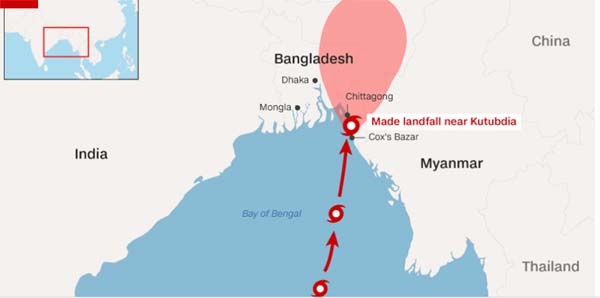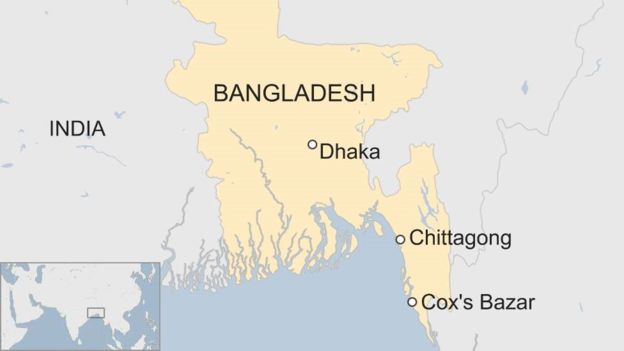
Route of Cyclonic storm Mora that made landfall in Bangladesh’s south-eastern coastal areas with heavy winds and rain on May 30 morning. Graphic: CNN
Dhaka, Bangladesh (BBN) – Powerful Cyclonic storm “Mora” made landfall Tuesday morning between the port of Cox’s Bazaar and the city of Chittagong in Bangladesh lashing the coastal areas with heavy rain and winds.
Hundreds of thousands of the country’s south-eastern coastal people have been moved to cyclone shelters.
After making the landfall, the storm ‘Mora’ over North Bay moved northwards and has started crossing Cox’s Bazar-Chittagong coast near Kutubdia at 6:00am on Tuesday, said a special bulletin of the Bangladesh Meteorological Department.
It is likely to move in a northerly direction further.
Under its influence gusty/squally wind with rain/ thunder showers is continuing over North Bay and the coastal districts and maritime ports of Bangladesh.
Maximum sustained wind speed within 64 kms of the cyclone centre is about 89 kph rising to 117 kph in gusts/squalls.
Sea will remain high near the system.
Maritime ports of Chittagong and Cox’s Bazar have been advised to keep hoisted great danger signal number ten.
Coastal districts of Chittagong, Cox’s Bazar, Noakhali, Laxmipur, Feni, Chandpur and their offshore islands and chars will come under danger signal number ten.
Maritime ports of Mongla and Payra have been advised to keep hoisted great danger signal nubmer eight.
Coastal districts of Bhola, Borguna, Patuakhali, Barisal, Pirozpur, Jhalakathi, Bagherhat, Khulna, Satkhira and their offshore islands and chars will come under danger signal number eight.
Under the influence of the severe cyclonic storm ‘Mora’ the low-lying areas of the coastal districts of Cox’s Bazar, Chittagong, Noakhali, Laxmipur, Feni, Chandpur, Borguna, Bhola, Patuakhali, Barisal, Pirozpur, Jhalakathi, Bagherhat, Khulna, Satkhira and their offshore islands and chars are likely to be inundated by storm surge of 4-5 feet height above normal astronomical tide.
The coastal districts of Cox’s Bazar, Chittagong, Noakhali, Laxmipur, Feni, Chandpur, Borguna, Patuakhali, Barisal, Bhola, Pirozpur, Jhalakathi, Bagerhat, Khulna, Satkhira and their offshore islands and chars are likely to experience wind speed up to 89-117 kph in gusts/ squalls with heavy to very heavy falls during the passage of the severe cyclonic storm.
All fishing boats and trawlers over North Bay and deep sea have been advised to remain in shelter till further notice.
BBC adds: Cyclone Mora has hit Bangladesh, lashing the country’s south-eastern coast with heavy rain and winds.
The powerful storm made landfall on Tuesday morning between the fishing port of Cox’s Bazar and the city of Chittagong, with winds of up to 117 km/h (73mph), Bangladesh’s Meteorological Department said.
Authorities have been moving more than one million people to shelters.
Parts of India and Myanmar are also expected to be affected.
It comes after heavy rains in Sri Lanka caused floods and landslides that killed at least 180 people.
Map showing Chittagong and Cox’s Bazar in Bangladesh
Bangladesh’s meteorological department had previously warned that low-lying areas of Cox’s Bazar, Chittagong and many other coastal districts were “likely to be inundated” by a storm surge of 1.2m-1.5m (4-5 feet) above normal levels.
Hundreds of thousands of people had been evacuated to cyclone shelters, schools and government offices as of late Monday.
Fishing boats and trawlers have been advised to remain in shelters as well.
Severe weather tracking website Tropical Storm Risk forecasts that Cyclone Mora will move northwards past Chittagong over the next 12 hours, weakening as it moves further inland and downgrading from a Category 1 hurricane to a tropical storm.
No casualties have been reported, but Reuters said the cyclone has caused significant damage to refugee camps for Rohingya Muslims.
Community leader Shamsul Alam told the news agency that almost all 10,000 thatched huts in two camps were destroyed.
Large camps have been set up in Cox’s Bazar for hundreds of thousands of ethnic Rohingya who have fled violence from neighbouring Myanmar.
The Bay of Bengal is prone to storms, and Bangladesh is often hit by severe weather during its rainy monsoon season from the middle to the end of the year.
CNN adds: Bangladesh is scrambling to evacuate nearly one million people from low-lying areas as a powerful tropical cyclone pounds the country’s southern coastline.
The cyclone, dubbed Mora, made landfall early Tuesday morning between the cities of Chittagong and Cox’s Bazar and is heading north, authorities in the capital Dhaka said.
“More people were still waiting for evacuation,” said Abu Syed Mohammad Hashim, acting director general of the department. Authorities have also shut airports and ports in the regions expected to be worst hit.
Khalid Mahmood, a director at Disaster Management Department, told CNN that no major casualties had been reported yet.
Residents were seeking shelter in schools and other safe buildings in 17 coastal districts, Hashim said. Officials have organized 3,800 relief centers ahead of the storm.
Medical teams have been formed and doctors and nurses have had their leave requests canceled in anticipation of the storm’s landfall, according to Bangladeshi state media. Hashim told the state-run news agency BSS that rescue teams comprised of members of the armed forces and other agencies were also on standby.
With about 700 kilometers of coastline, Bangladesh is exposed to cyclones and is often battered by deadly storms. Seven of the top ten deadliest storms in recorded history have occurred in either Bangladesh or Myanmar, according to CNN meteorologist Pedram Javaheri.
“A combination of its lengthy and exposed coastline, inadequate infrastructure and plenty of fuel in the way of warm Bay of Bengal waters play a role in making this region the deadliest in the world as it relates to tropical cyclones,” Javaheri said.
At the southern end of the Bay of Bengal, Sri Lanka has been experiencing heavy monsoon rains and severe flooding, which have left at least 160 people dead and dozens more missing. The two weather systems, however, are unrelated.
Nearly 300,000 people were evacuated as Cyclone Mora barrelled towards Bangladesh's southeastern coast at speeds of more than 85 kilometres (53 miles) per hour, officials said.
Nearly 300,000 people were evacuated as Cyclone Mora barrelled towards Bangladesh’s southeastern coast at speeds of more than 85 kilometres (53 miles) per hour, officials said.
Airports closed
Mora is the equivalent of a strong tropical storm and will bring winds around 100 kilometers per hour as it moves onshore, said CNN meteorologist Taylor Ward. A more significant problem than the winds will be the potential for flooding — from storm surge and heavy rainfall, he said.
“The coastline of Bangladesh is very low-lying and is prone to storm surge problems,” Ward said. “Additionally, tropical cyclones in the region bring extremely heavy rainfall which often turns deadly in the densely populated areas.”
In May 2016, Cyclone Roanu made landfall in Bangladesh with similar speed winds causing the deaths of at least two dozen people.
Some low-lying areas of Cox’s Bazar are already underwater due to an unusually high tide, state media reports.
The country’s two main seaports in Chittagong and Mongla have suspended container handling, and river transports across Bangladesh have been suspended. Chittagong and Cox’s Bazar have been advised to hoist the number 10 warning signal — the highest level — and other areas the lesser number eight signal.
The airports of Chittagong and Cox’s Bazar have also been closed; Cox’s Bazar indefinitely and Chittagong’s Shah Amanat International Airport until at least 2 p.m. local time (4 a.m. ET) Tuesday.
“We will reopen the airport if weather permits after 2 p.m. tomorrow… the suspension period will linger if the brunt of cyclone badly affects our airport infrastructure,” CAAB flight safety director Ziaul Kabir was quoted as saying.
BBN/SS/ANS








